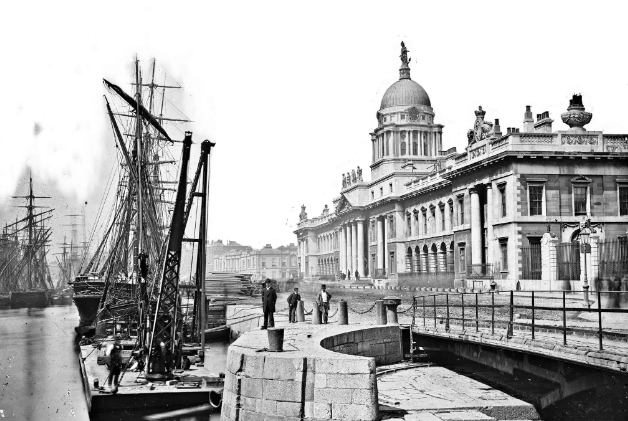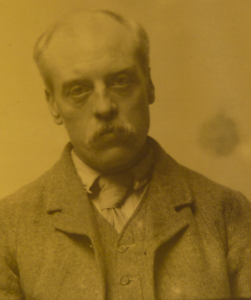b.1883-d.1911
An early life in Dublin
All that is known about Kate’s early life is that she came from Dublin and that her father’s name was William Murray. His occupation was that of a sweep. Kate appeared in London in 1901 as an unmarried servant. She was a Roman Catholic and she could read and write.
At some stage, Catherine or Katherine became Kate and that is what she preferred to call herself.
Some family trees on Ancestry have researched her early life and have come up with the following hypothesis.
Kate was born Catherine Murray on 29 April 1883 in 11 Brunswick Road in Dublin Ireland. Her parents were William Murray and Margaret McEvoy. She was baptised into the Roman Catholic faith on 7 May 1883 at St Andrews, Westland Row church in Dublin and her godparents were named as James McGrath and Catherine Murray.
She was probably the second child of her parent’s marriage. They had married in St Andrews, Westland Row church on 11 Jan 1881. An older sister for Kate named Margaret was born on 27 May 1881 and baptised two days later at the same church in Dublin.
This family lived in the South Dublin Dock area just off Sandwith Street.
Unfortunately, there are no surviving records for the Irish 1881 and 1891 census returns so the family cannot be traced. I cannot trace any further children of the marriage either. There are also many William Murray’s in Ireland so there are many possibilities. Sadly, Kate’s early life cannot be proved.
Luckily, from late 1901, we can trace her life in England and her story from that point does have solid evidence.
1901
I have found it difficult to trace Kate with any definite links in the Irish or English Census in 1901. I have found a potential entry for her living as a servant at 20 Regents Park Road in St Pancras.
Her employer is George F Barwick who worked at the British Museum who went on to be Superintendent of the Reading Rooms. Place of birth is given as Dublin, but her age is recorded as 22 and not 20. There are a few potential entries in the Irish Census for Kate living in Dublin as a servant.
A contender for Kate?
This is possibly the strongest contender in Dublin I could find – an entry for Grosvenor Square, House 282, Rathmines in Dublin. There is a Kate Murray living and working as a servant to a Thomas Taylor, who was an unmarried Bankers Clerk, aged 48.
He is living there with his 70-year-old widowed mother Cordelia Taylor and his four brothers. These were Frederick an unmarried civil servant aged 38, Alfred an unmarried cashier at a distillers aged 32, Archibald who was married aged 30 and unemployed and Herbert an unmarried stockbroker’s clerk aged 22.
A move to London
So, it is not clear when Kate moved to London but what is certain is that she was admitted to Constance Road Workhouse in Camberwell on 18 September 190. From there she was transferred to Westmorland Road workhouse in Newington on 19 September 1901.
She was described as a single servant, aged 20 years old and being of the Roman Catholic faith. On the next day, she was discharged to the Champion Hill Infirmary. She then seems to have been returned to the workhouse on 5 October before being returned again to The Champion Hill Infirmary.
The reason for her ill health may have been pregnancy related, as she gave birth to a daughter named Gladys Mary Murray on 23 December 1901 at the Infirmary. There is no father noted on the birth certificate.
Without concrete evidence it is difficult to know whether Kate was in Ireland or London when she became pregnant.
Gladys’s baptism took place at the English Martyrs Roman Catholic Church on 8 March 1902. Her godmother was Agnes Knight.
The records show that Kate and Gladys had been back in the workhouse on 19 February 1902, being discharged to the Infirmary on 8 March and being transferred back to Westmoreland Road Workhouse on 19 March before a final discharge at Kate’s request on 7 May 1902. The baptism record confirms that Kate and Gladys were in Newington Workhouse at the time. Not a good start for baby Gladys.
Married Life
Things appear to improve for Kate when on 3 April 1904 she married Joseph William Latham Andrews in a Church of England ceremony at St Peter’s Church, Walworth. Joseph was a bachelor aged 27, whose occupation was that of a horse keeper.Their address was given as 96 Westmoreland Road.
His father was William Andrews but the occupation of his stepfather was given – horse keeper. Joseph’s real father had died when he was 2 years old. Kate’s father’s occupation was that of a sweep. Both parties could write and signed their names on the certificate. The witnesses were Joseph and Mary Harris.
A Son is born
Just over 11 months later, their first son was born on 5 March 1905, and he was called Joseph Latham Andrews after his father. Information from an Ancestry Tree shows he was born at 13 Sandes Street in Newington. Joseph was joined by a brother, William, on 21 July 1907 when the family address was given as 14 Bath Place. Their last child Mary was born 1 April 1909 by then the family address was 25 Loncroft Road in Camberwell. All these addresses are classified as “mixed” by Booths Maps.
Life takes a downturn
Sadly, in 1910, life began to go wrong for the family. Kate appears to have become unwell in July 1910, which culminated in her and her young family all being admitted to Westmoreland Road Workhouse on 17 August 1910. The children were all under 10 years of age. Gladys being not quite 9 years old, Joseph 5 years old, William 3 years old and Mary only 16 months old.
The children were all described as being of the Roman Catholic faith. The children were separated from Kate and discharged back to the care of their father the next day, where they were living at 2a Minnow Street, Walworth.
From Kate’s Reception Order dated 18 August 1910 it became clear why this had happened and some of the distress Kate felt. She was described as a 27-year-old housewife and that the current attack had started about one month ago.
There appeared to be no apparent cause. She was not suffering from epilepsy and was not suicidal. Under the question was she a danger to others it was noted she had a, ‘very violent temper’.
An Assessment of Kate
The medical practitioner who examined her concluded she was a person of “unsound mind”. The facts observed were as follows –
“Patient’s manner appears absent, gives way to fits of weeping and demands her children whom she has been recently separated. Declares that her landlady has told her husband that she hates him. Her physiognomy suggests congenital syphilis”.
On 24 August 1910 she was sent to Long Grove Hospital. It is no wonder that Kate was distraught being separated from her young children in such a swift and seemingly uncaring way.
In the 1911 Census, Kate is recorded twice, once by her husband and then at Long Grove.
Kate did not return home and died at Long Grove on 8 July 1911, of broncho pneumonia and she was buried in Grave 1026b in Horton Cemetery. She probably never saw her children again after they were taken from her.
How did Joseph Cope?
The Census of April 1911 shows the family altogether at 2a Minnow Road. Kate has been recorded as Mary Andrews still living at home although we know she was at Long Grove. There could be a range of reasons for this, so it is hard to speculate why. Joseph was recorded as being aged 34 and married for 7 years and having four living children.
The children Gladys (now using the surname of Andrews) aged 9, Joseph aged 6, William aged 4 and Mary aged 2. Also living at the address was William Lucy (Joseph’s stepfather) aged 62 and Lillie Lucy (Joseph’s sister) aged 20.
Prior to this, there must have been difficulties at home as Joseph, William and Gladys were admitted on 2 November 1910 to the Boyson Road Children’s Home. This was situated at 194 – 200 Boyson Road and run by Southwark Poor Law Union. Fortunately, this was only short term as on 22 November 1910, they returned to their father. One can only imagine that perhaps William and Lillie Lucy helped to raise the young family.
Survive they did
During World War 1 Joseph senior enlisted in the Royal West Kent Regiment and became a Sergeant. Oddly, he used the surname of his stepfather and served under the name of Lucy. What military records exist do so under the name of Joseph William Lucy.
In the 1921 Census, the family excluding Gladys can be found at 4 Borrett Road in Newington: Joseph junior aged 16, William aged 14 and Mary aged 12 who was still a full-time scholar. Their father, Joseph senior, is a patient at the Ministry of Pensions Hospital at Ruskin Park, Denmark Hill. This hospital was known as the Fourth London General Hospital; it was built to nurse wounded soldiers and some TB patients.
So, it appears the children were fending for themselves at this time but must have managed very well. Gladys, Joseph junior and William all went on to marry and live to a good age. Sadly, I have been unable to trace what happened to Mary Andrews.
Joseph senior went on to remarry on 22 February 1922 a young widow called Ada Brett and lived until 1937.
Authors Conclusion
It is frustrating that I have been unable to trace Kate’s early life and what happened to her parents. It is also unclear what led to her arrival in the city of London. Probably, she was hoping for a better life.
Whether she was pregnant when she arrived is also unknown so she could have been running away or it was something that happened on her arrival. It seems her pregnancy was problematic as she spent time in and out of the Infirmary and her daughter was born there. Possibly she had nowhere to go.
Marriage you would hope would have saved her, but after a few years she became ill, which led to her being admitted to the workhouse and being cruelly separated from her young children. The notes on the Reception Order are heartbreaking and her distress can be seen at the loss of her children. The tentative diagnosis of “congenital syphilis” cannot be proved. If she did suffer with this, there is no evidence this affected her husband or children.
I can only feel sorry for this young woman who came to London to probably better herself. The loss of her family and ultimately her life is a sad tale. The fact that her children survived and apparently led full and long lives is testament to her.




